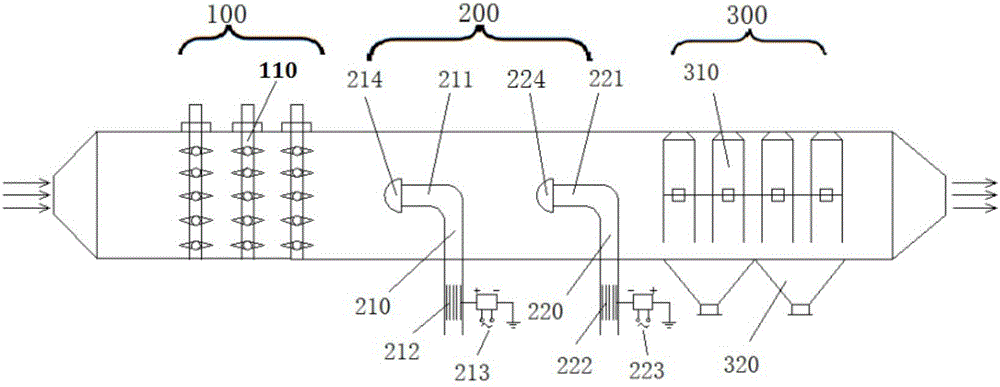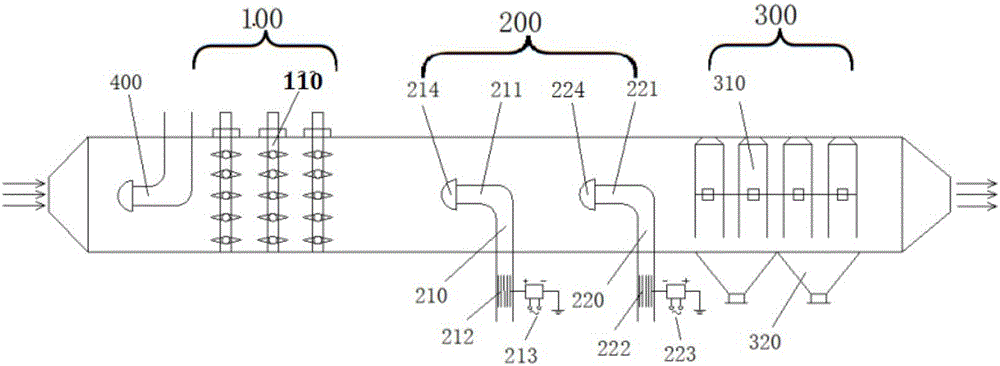Method for removing sintering flue gas fine particles based on pulse discharge
A fine particle and pulse discharge technology, which is applied in chemical instruments and methods, power supply technology, electrostatic separation, etc., can solve the problems that it is difficult to effectively control the emission of fine particles in the sintering flue gas, and the treatment effect of fine particles is limited, so as to improve the agglomeration and detachment. The effect of removing efficiency, promoting reunion growth, and controlling emissions
- Summary
- Abstract
- Description
- Claims
- Application Information
AI Technical Summary
Problems solved by technology
Method used
Image
Examples
Embodiment 1
[0043] like figure 1 As shown, a method for removing fine particles from sintering flue gas based on pulse discharge of the present invention, the emission reduction steps are as follows:
[0044] Step 1: Pulse charging of fine particles
[0045] The flue gas first enters the pretreatment unit 400 of the removal device for pretreatment. The removal device is the above-mentioned device for removing fine particles of sintering flue gas by pulse corona charging. The pretreatment unit 400 includes a pretreatment nozzle 410, the pretreatment nozzle 410 is used to spray the mist of agglomerating agent or water or salt solution into the flue gas, and the particle size of the mist droplet is 0.2-3 μm; Particles, agglomerating agent or water or salt solution form a coating layer on the surface of fine particles, increasing the particle size in the particles, making the particles avoid the medium particle size, and reducing the proportion of fine particles in the medium particle size r...
Embodiment 2
[0062] like figure 2As shown, the basic content of this embodiment is the same as that of Embodiment 1, the difference is that: it also includes a pretreatment unit 400, and the pretreatment unit 400 is used to spray the mist of agglomerating agent or water or salt solution into the flue gas. In this embodiment, water is used, and the particle size of the agglomerating agent or water sprayed into the pretreatment unit 400 is 0.2-3 μm. The pretreatment unit 400 includes a pretreatment nozzle 410, which is used to spray agglomerating agent or water or salt solution droplets into the flue gas, and what is sprayed in this embodiment is: water droplets , The droplet size is 0.2-3μm.
[0063] The emission reduction effect of fine particles using the removal device is as follows, wherein: PM10 emission reduction efficiency (%) is: 47.1%, PM2.5 emission reduction efficiency (%): 34.3%, improving the emission reduction effect of fine particles. Compared with Example 1, PM10 emission...
Embodiment 3
[0067] like image 3 and Figure 4 As shown, the basic content of this embodiment is the same as that of Embodiment 2, except that: the pretreatment unit 400 is arranged on the pipeline axis of the expansion tube 510, and the pretreatment unit 400 includes a pretreatment nozzle 410 and a flow guide Components 420, wherein the flow guiding component 420 is arranged on the windward side of the pretreatment nozzle 410, and the flow guiding component 420 is set at the pipe wall edge position of the expansion pipe 510, wherein the flow guiding component 420 includes a first flow guiding block 421 and a second flow guiding block 421 The flow guide block 422, the first flow guide block 421 is arranged on the windward side of the second flow guide block 422, the first flow guide block 421 and the second flow guide block 422 are arranged at the edge position of the expansion pipe 510, and the pretreatment nozzle There is no deflector block directly in front of 410, which strengthens t...
PUM
| Property | Measurement | Unit |
|---|---|---|
| frequency | aaaaa | aaaaa |
| particle diameter | aaaaa | aaaaa |
Abstract
Description
Claims
Application Information
 Login to View More
Login to View More - R&D Engineer
- R&D Manager
- IP Professional
- Industry Leading Data Capabilities
- Powerful AI technology
- Patent DNA Extraction
Browse by: Latest US Patents, China's latest patents, Technical Efficacy Thesaurus, Application Domain, Technology Topic, Popular Technical Reports.
© 2024 PatSnap. All rights reserved.Legal|Privacy policy|Modern Slavery Act Transparency Statement|Sitemap|About US| Contact US: help@patsnap.com










